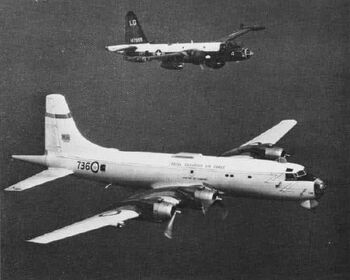
The Canadair CL-28 Argus was a maritime reconnaissance and anti-submarine aircraft of the Royal Canadian Air Force.
History and Design[]
Development of the CL-28 began in April 1954, with the goal to succeed the aging Lancaster and Neptune aircraft of the Royal Canadian Air Force in their maritime reconnaissance and anti-submarine role. The aircraft was first flown on 28th March 1957. During this time it was the largest Canadian aircraft ever built. The aircraft was based on the Bristol Britannia, while it has the same wings, undercarriage and tailsection. The difference was that

An illustration.
it was modified into American standard, meaning the same basic design, but with new American parts, which replaced the old Brtish ones.
Canadair completely redesigned the fuselage and the interior of the aircraft, while the Britannia's fuselage had a pressurized cabin, the Argus's was unpressurized and was modified to carry bombs in it. Instead of the Bristol Proteus turboprop engines, the Argus was powered by Wright R-3350 Turbo-Compound engines, with a power of 2,535 kW each, because these had a lower fuel consumption, allowing it, to improve its maximum flight endurance. At the very beginning of its service time, the CP-107 Argus (its Canadian designation), was considered as the most advanced aircraft of its class.